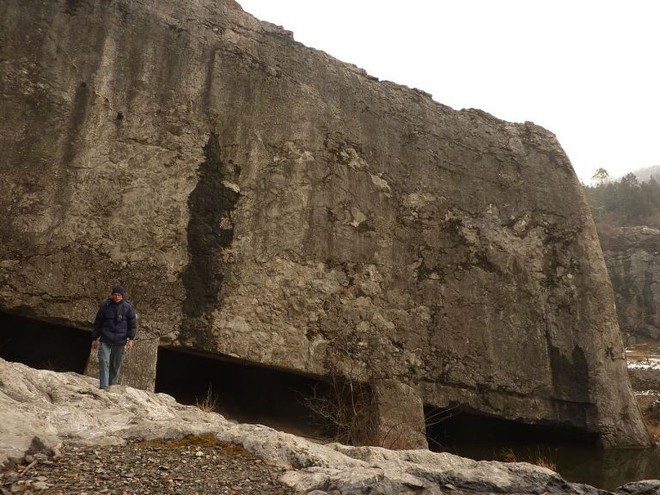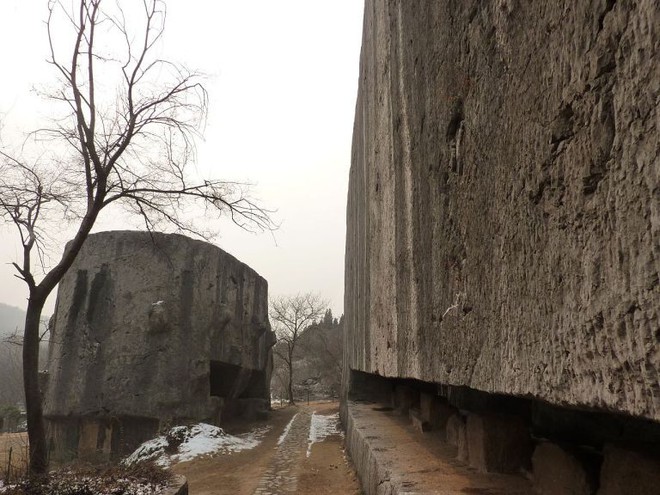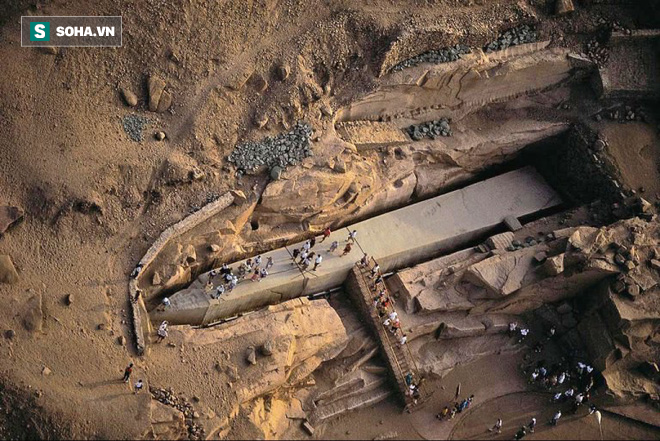Mysterious stone tablet in China: Weighs more than 31,000 tons, almost as tall as the Statue of Liberty
The interesting story behind this tombstone will help us better understand why this tombstone is located in a quarry instead of in a mausoleum as originally intended.
Stone structures from ancient times always make us amazed and confused, many civilizations have such mysterious stone structures such as the Pyramids of Egypt, Stonehenge in England, stone statues on Easter Island (Chile)…
Mystery of giant stone tablet weighing more than 30,000 tons in China
The giant stone stele, whose pedestal alone weighs 16,300 tons, is called the Yangshan Quarry. While the entire structure is said to weigh 31,300 tons in China.

The pedestal of the giant stone stele weighs more than 16,000 tons. Photo: Ancientcode
Located near the present-day city of Nanjing, Yangshan Quarry was a quarry that provided massive amounts of stone for the construction of temples in Nanjing and surrounding areas. But now it is a site of great historical importance.
Giant stone stele becomes attractive tourist destination. Source: Vladimir Menkov
This limestone quarry has been exploited for 6 dynasties to build architectural projects, walls, statues and temples. Among them, the giant tombstones here are a testament to the construction techniques and skills of ancient stonemasons.
The Story Behind the Giant Tombstone
In 1405, the Yongle Emperor, the third emperor of the Ming Dynasty, who reigned from 1402 to 1424, ordered a giant tombstone to be cut in Yangshan Quarry, to be used for the construction of the Ming Xiaoling mausoleum for his deceased father, Emperor Zhu Yuanzhang.

The pedestal of the tombstone. Photo: Ancientcodes

No one can move the tombstone once it is completed. Photo: Ancientcodes
He wanted to build a tombstone worthy of his father’s reputation as the founding emperor of the Ming Dynasty. The huge stone block from the quarry was then cut into three pieces to make this tombstone.
The first rectangular block is the pedestal, the second block is the body of the stele and the last block is the head of the stele (decorated with dragon motifs), no one thought much about the enormous weight of the stone block until the stele was almost completed.
Only then did people start thinking about moving it and the problem began! No one could figure out how to move such a massive stone weighing more than ten thousand tons.

The tombstone block is complete but cannot be moved. Photo: Ancientcodes
Ultimately, the architects of the time concluded that it was impossible to move the giant stele to Ming Xiaoling’s tomb, let alone place it there properly, and the entire project was halted just as it was about to be completed.
That is why this quarry has such a huge tombstone in Yangshan Quarry. This tombstone is 30m long at the base, 16m wide and 13m high, weighing 16,300 tons, while the body is 50m high, 10.7m wide and 4.4m thick, weighing about 9,000 tons.
The head of the tombstone, beautifully carved with dragons, is smaller, about 11m high, 20.3m wide and 8m thick, weighing about 6,000 tons.
The two authors Yang & Lu in the book “Ming and Qing architecture of Nanjing” believe that if the stele is moved and placed in its predetermined position, its standing height can reach 73m (nearly the height of the Statue of Liberty today, 93m).
News
The Hanging Temple: China’s 1,500-Year-Old Cliffside Marvel of Faith and Engineering
The Hanging Temple: China’s 1,500-Year-Old Cliffside Marvel of Faith and Engineering Perched precariously on the cliffs of Mount Heng in Shanxi Province, China, the Hanging Temple, also known as Xuankong Temple, Hengshan Hanging Temple, or Hanging Monastery, is an architectural…
The Willendorf Venus: A 30,000-Year-Old Masterpiece Reveals Astonishing Secrets
The Willendorf Venus: A 30,000-Year-Old Masterpiece Reveals Astonishing Secrets The “Willendorf Venus” stands as one of the most revered archaeological treasures from the Upper Paleolithic era. Discovered in 1908 by scientist Johann Veran near Willendorf, Austria, this small yet profound…
Unveiling the Maya: Hallucinogens and Rituals Beneath the Yucatán Ball Courts
Unveiling the Maya: Hallucinogens and Rituals Beneath the Yucatán Ball Courts New archaeological research has uncovered intriguing insights into the ritual practices of the ancient Maya civilization. The focus of this study is a ceremonial offering found beneath the sediment…
Uncovering the Oldest Agricultural Machine: The Threshing Sledge’s Neolithic Origins
Uncovering the Oldest Agricultural Machine: The Threshing Sledge’s Neolithic Origins The history of agricultural innovation is a fascinating journey that spans thousands of years, and one of the earliest known agricultural machines is the threshing sledge. Recently, a groundbreaking study…
Nara’s Ancient Sword: A 1,600-Year-Old Protector Against Evil Spirits
Nara’s Ancient Sword: A 1,600-Year-Old Protector Against Evil Spirits In a remarkable discovery that has captured the attention of archaeologists and historians alike, a 7.5-foot-long iron sword was unearthed from a 1,600-year-old burial mound in Nara, Japan. This oversized weapon,…
The Inflatable Plane, Dropped Behind the Lines for Downed Pilots
Experimental The Inflatable Plane, Dropped Behind the Lines for Downed Pilots The Inflatoplane from Goodyear was an unconventional aircraft developed by the Goodyear Aircraft Company, a branch of the renowned Goodyear Tire and Rubber Company, also famed for the Goodyear…
End of content
No more pages to load











